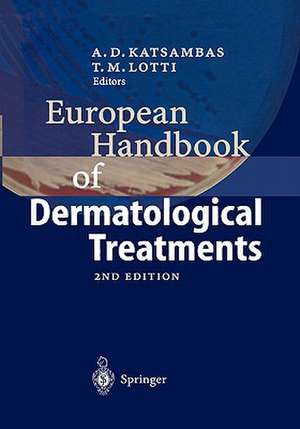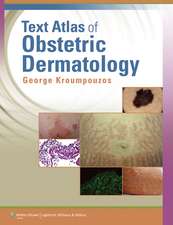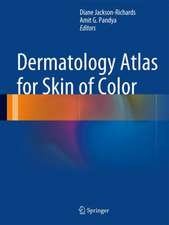European Handbook of Dermatological Treatments
Editat de Andreas D. Katsambas, Torello M. Lottien Limba Engleză Paperback – 29 noi 2010
Preț: 749.18 lei
Preț vechi: 788.60 lei
-5% Nou
Puncte Express: 1124
Preț estimativ în valută:
143.40€ • 155.82$ • 120.53£
143.40€ • 155.82$ • 120.53£
Carte tipărită la comandă
Livrare economică 21 aprilie-05 mai
Preluare comenzi: 021 569.72.76
Specificații
ISBN-13: 9783642056574
ISBN-10: 3642056571
Pagini: 824
Ilustrații: XVII, 804 p.
Dimensiuni: 170 x 244 x 43 mm
Greutate: 1.4 kg
Ediția:2nd ed. 2003
Editura: Springer Berlin, Heidelberg
Colecția Springer
Locul publicării:Berlin, Heidelberg, Germany
ISBN-10: 3642056571
Pagini: 824
Ilustrații: XVII, 804 p.
Dimensiuni: 170 x 244 x 43 mm
Greutate: 1.4 kg
Ediția:2nd ed. 2003
Editura: Springer Berlin, Heidelberg
Colecția Springer
Locul publicării:Berlin, Heidelberg, Germany
Public țintă
Professional/practitionerDescriere
Dermatology is a specialty in the field of medicine which constantly changes at a vast rate. Alongside technology, new drugs, methods and treatments are continuously developed for the treatment of all common skin diseases. The first edition of the European Handbook of Dermatological Treatments received an overwhelming response from dermatovenereologists all over Europe. Its easy-to-read format, which is also used for this 2nd edition, is aimed at helping the physician to obtain comprehensive information at a glance. The three main sections listed alphabetically define the different diseases, the drugs available and the various methods of treatment used in dermatological practice. Each chapter begins with a brief section of the aetiology and pathogenesis of the skin disease, and leads into the description of the clinical characteristics, the diagnosis and the differential diagnosis. Followed by a detailed discussion on treatment methods, alternative methods are covered as well. Each section ends with a reference list for further reading. This new edition provides an excellent update including the newest developments of drugs, methods and treatments in dermatological practice, maintaining the clear structure and well-proven format. It is a very comprehensive and practical guide and should not be missed by those treating patients with skin diseases.
Cuprins
Diseases.- Acne. Acne Inversa. Actinic Keratosis. Adamantiades-Behcet's Disease. Alopecia Areata Management. Androgenic Alopecia. Antiphospholipid Syndrome. Aphthous Stomatitis. Apocrine Miliaria. Atopic Dermatitis. Balanitis. Based Cell Carcinoma. Bowen's Disease. Bullous Pemphigoid. Candidiasis (Candidosis-Moniliasis-Trush). Chronic Actinic Dermatitis. Cicatricial Alopecia. Contact Dermatitis. Cutaneous Vasculitis. Darier's Disease. Dermatitis Herpetiformis. Dermatomyositis. Dermatophyte Infections. Diaper Dermatitis. Drug-Induced Pemphigus. Drug Eruption. Drug Photoosensitivity. Eccrine Miliaria. Epdermolysis Bullosa. Erysipelas. Erythema Multiforme. Erythema Nodosum. Erythrasma. Erythroplasiia of Queyrat. Factitial Dermatitis. Folliculitis. Furuncles and Carbuncles. Gonorrhoea. Granuloma Annulare. Hand Dermatitis. Herpes Simplex Genitalis. Herpes Simplex Virus Infection (Oro-facial). Herpes Zoster. Hirsutism. HIV Infection and AIDS. Hyperhidrosis. Ichthyoses. Impetigo. Kaposi's Sarcoma. Keloids and Hypertrophic Scars. Keratoacanthoma. Leg Ulcers. Leishmaniasis. Lentigo Maligna. Leprosy of Hansen's Disease. Lichen Planus. Lichen Simplex Chronicus. Lupus Erythematosus. Lymphomas Primary Cutaneous. Malignant Melanoma. Mastocytosis (Urticaria Pigmentosa). Melasma. Mite Bites. Molluscum Contagiosum. Morphea: Circumscribed Scleroderma. Necrobiosis Lipoidica. Nevi (Benign Melanocytic).Nummular Eczema. Pediculosis. Pemphigus Erythematosus. Pemphigus Foliaceus. Pemphigus Vegetans. Pemphigus Vulgaris. Photoageing. Pityriasis Lichenoides Acuta. Pityriasis Lichenoides Chronica. Pityriasis Rosea. Pityriasis Rubra Pilaris. Polymorphic Light Eruption (PLE). Porphyrias. Pruritus. Psoriasis. Purpuras. Pyoderma Gangrenosum. Raynaud's Phenomenon. Rosacea. Sarcoidosis. Scabies. Seborrheic Dermatitis. Seborrheic Keratosis. Sjögren's Syndrome. Skin Diseases from the Marine Environment. Solar Urticaria. Squamous Cell Carcinoma. Subacute Cutaneous Lupus Erythematosus. Syphilis.Systemic Sclerosis - Scleroderma. Tick Dermatoses. Tinea Versicolor.Pityriasis Versicolor. Toxic Epidermal Necrolysis. Urethritis: Gonococcal. Urethritis: Nungonococcal. Urticaria. Varicella. Vascular Birthmarks: Vascular Malformations and Haemangiomas. Vitiligo. Warts and Condylomas. Xanthomas. Methods.- Biopsy. Chemical Peelings. Cryosurgery. Curettage. Electrosurgery. Epiluminescence Microscopy of Pigmented Skin Lesions. Extrracorporeal Photochemotherapy. Hair Restoration Surgery. Lasers in Dermatology. Moh's Surgery. Patch Testing. Photochemotherapy. Sclerothery. Skin Augmentation (Fillings). Skin Resurfacing with the CO2 Laser. UVB Phototherapy. Vaccine Strategies via Dendritic Cells in the Treatment of Malignant Melanoma. Drugs.- Antibacterial Agents in Dermatology. Antifungals. Antihistamines. Antiviral Drugs. Bleaching Agents. Corticosteroids Topical. Glucocorticoids Systemic. Insect Repellents. Psychoactive Agents in Dermatology. Retinoids. Scabicides and Pediculicides. Sunscreens. Topical Anaesthetics in Dermatology. Topical Preparation and Vehicles.
Recenzii
From the reviews of the second edition:
"The book is an updated edition of the first one which was well accepted by dermatologists and other medical professionals. … To write such a compendium is a daring and ambitious enterprise. … full credit has to be given to the Editors for their endeavor in preparing this excellent and extensive handbook. … The Editors and coauthors succeeded in gathering a cornucopia of information, extremely useful to residents, practicing dermatologists, general practitioners and other specialists as well as to experienced teachers of dermatology." (Aleksej Kansky, Acta Dermatovenerologica, Vol. 13 (1), 2004)
"The book is an updated edition of the first one which was well accepted by dermatologists and other medical professionals. … To write such a compendium is a daring and ambitious enterprise. … full credit has to be given to the Editors for their endeavor in preparing this excellent and extensive handbook. … The Editors and coauthors succeeded in gathering a cornucopia of information, extremely useful to residents, practicing dermatologists, general practitioners and other specialists as well as to experienced teachers of dermatology." (Aleksej Kansky, Acta Dermatovenerologica, Vol. 13 (1), 2004)
Textul de pe ultima copertă
Dermatology is a specialty in the field of medicine, which constantly changes at a vast rate. Alongside technology, new drugs, methods and treatments are continuously developed for the treatment of all common skin diseases. The first edition of "The European Handbook of Dermatological Treatments" received an overwhelming response from dermatovenereologists all over Europe. Its easy-to-read format, which is also used for this 2nd edition, is aimed at helping the physician to obtain comprehensive information at a glance. The three main sections listed alphabetically define the different diseases, the drugs available and the various methods of treatment used in dermatological practice. Each chapter begins with a brief section of the aetiology and pathogenesis of the skin disease, and leads into the description of the clinical characteristics, the diagnosis and the differential diagnosis. Followed by a detailed discussion on treatment methods, alternative methods are covered as well. Each section ends with a reference list for further reading. This new edition provides an excellent update including the newest developments of drugs, methods and treatments in dermatological practice maintaining the clear structure and well-proven format. It is a very comprehensive and practical guide and should not be missed by those treating patients with skin diseases.
Caracteristici
Presents updated data concerning the most common dermatological diseases. Detailed information on current therapies and future expectations. All contributors are European specialists and present the topic in a new, easy to read manner, with emphasis on the educational aspect.
Due to the encyclopedic structure of the book the reader has easy access to updated information on the diagnosis, the differential diagnosis and the treatment of all common skin diseases.
Due to the encyclopedic structure of the book the reader has easy access to updated information on the diagnosis, the differential diagnosis and the treatment of all common skin diseases.









